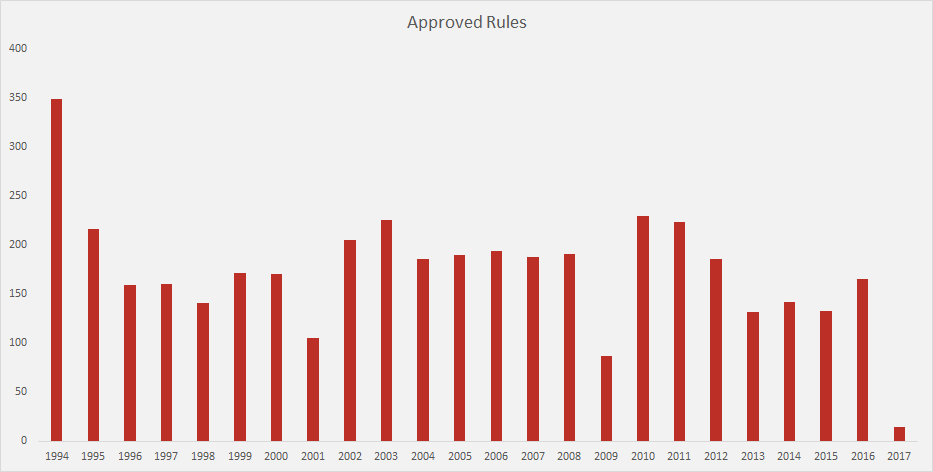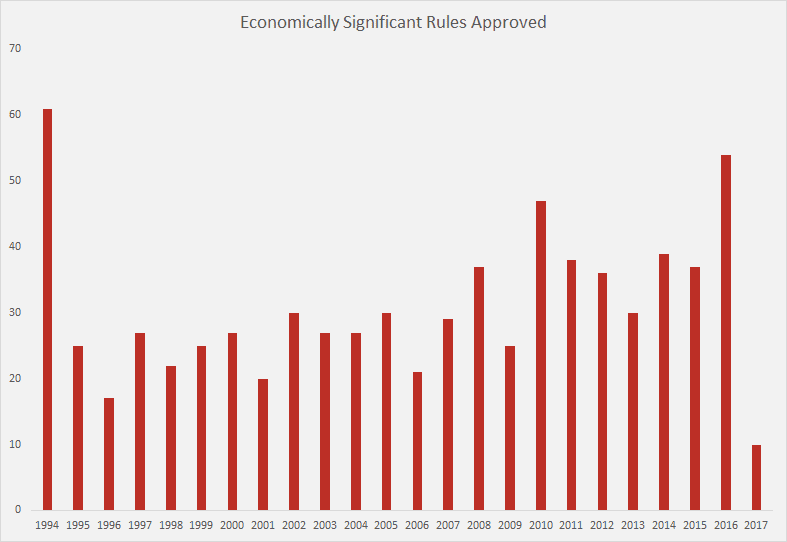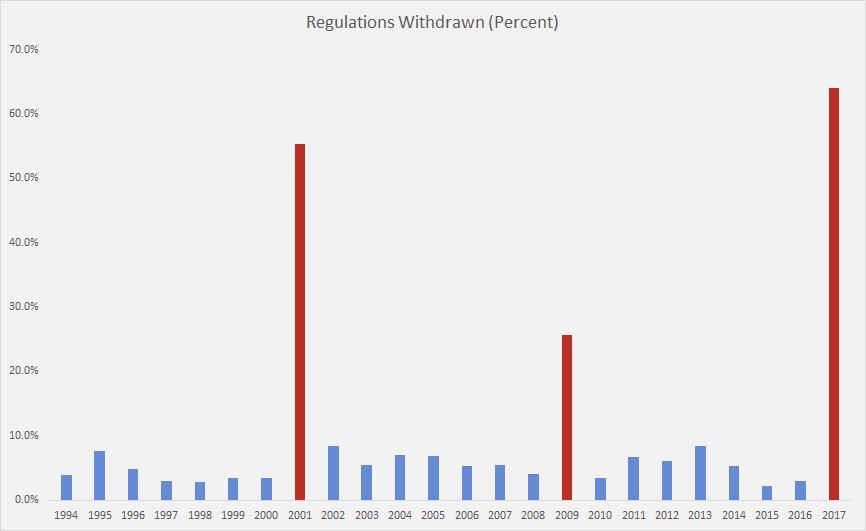Insight
June 6, 2017
The Historic Nature of the Regulatory Slowdown
How profound is the recent regulatory slowdown? The White House has released just 8 percent of the historical volume of regulation. Cabinet agencies have only finalized $33 million in costs, compared to a 2005 to 2017 average of $26 billion. On the cost side, regulatory output is just 0.12 percent of historic norms. As the American Action Forum (AAF) has detailed in the past, the “Regulatory Freeze” that took effect on day one of the administration has persisted for roughly the first four months of President Trump’s term. By virtually any measure, dating back through two Democratic presidents and one Republican president, the lack of regulatory output is historic.
Methodology
For this research, AAF collected data from the Office of Information and Regulatory Affairs (OIRA) on cabinet-level regulatory output from 1994 to 2017 (from post-Inauguration to May 23, roughly the first four months of each presidential term). This included:
- Number of rules reviewed
- Economically significant reviews
- Number of withdrawn rules
- Number of approved regulations (total reviews minus withdrawn rules)
- Number of significant rules reviewed (significant reviews minus withdrawn rules)
For consistent comparisons, AAF collected data from January 23 to May 23 during each year, even though there was only a presidential transition in 2001, 2009, and 2017. From this data, AAF was able to calculate the percentage of economically significant rules for each period and the percentage of withdrawn rules.
Finally, AAF has data on final regulatory costs from 2005 to present. AAF recorded final costs during this January 23 to May 23 period.
Results
For those expecting the Trump Administration to regulate as usual in 2017 (an average of 173 approved rules from 1994 to 2017), they were disappointed. For those expecting a 50 percent cut in regulatory output, they can be heartened that actual output was just 8 percent of the historical average.
Across the board, the results indicate a significant diminution in the number of regulations approved and a notable uptick in the number of withdrawn measures (previous rules from the Obama Administration no longer under consideration). For instance, during the period covered, the average administration reviewed 190 rules; the Trump Administration reviewed 39. In the average year, there were 33 economically significant reviews; the Trump Administration reviewed just 16. On average, there were 30.8 significant rules approved, not just reviewed; this administration has released ten.
The graphs below illustrate current regulatory output, in both total and economically significant approved rules.
In some respects, the regulatory record has outpaced historic norms. For example, during the period studied there were an average of 16 withdrawn rules. These were measures under consideration, but pulled back by OIRA. The Trump Administration withdrew 25. However, on this note, both President Barack Obama and George W. Bush greatly exceeded those totals, withdrawing 30 and 130 rules, respectively. Yet, examining the number of withdrawn rules compared to all output from OIRA, and the Trump Administration surges into the lead. For example, 64 percent of the OIRA reviews have resulted in withdrawn rules. This compares to 25 percent in 2009 and 55 percent in 2001. The graph below illustrates these totals.
On regulatory costs, the picture is the same. Including independent agency actions, there have been $4.2 billion in regulatory costs since January 23, 2017. The 2005 to 2017 average is $26 billion. In other words, the administration is regulating at roughly 16 percent of the historical average. When only cabinet-agency totals are included from 2017 (just $33 million), this percentage drops to 0.12 percent of the historical average. For perspective, the Obama Administration finalized $58 billion in regulatory costs during roughly the first four months of 2016. President Bush approved $22 billion in costs during this period in 2008.
Future Totals?
Given the unprecedented lack of regulatory output, both critics and supporters alike might wonder whether these trends can persist. The public will receive its first clue when the administration releases its first “Unified Agenda” of federal regulations. Typically released around May or June annually, this document will give the public its first glimpse of what regulations the administration wants to pursue and what deregulatory actions are required to satisfy the one-in, two-out executive order.
Perhaps the biggest driver to move the regulatory needle somewhat near the historical average is the judiciary. If the administration suffers defeat after defeat in its desire to limit regulatory growth, or to regulate with standards that don’t satisfy existing statutes, judicial deadlines will impose unavoidable regulatory costs. Unlike statutory deadlines, judicial timeframes for regulation are rarely avoided (and for good reason).
For the interim, without a confirmed OIRA Administrator or pending statutory or judicial deadlines, there is little reason to believe the administration cannot continue to set records for limiting regulatory burdens. It might be a stretch to predict they will continue to regulate at 8 percent or less of the historic average, but there are few regulations under review now that will tip the balance toward a more aggressive regulatory stance. In fact, many of the pending rules are stays of existing measures or deregulatory actions that will reduce burdens.
Conclusion
Regardless of the metric employed, there is little doubt regulatory output is at historic lows. The regulatory freeze has not been temporary, but relatively permanent. This is especially true when considering regulatory costs from the administration alone. Although OIRA has approved more than a dozen rules, they have resulted in just $33 million in costs, or merely 0.12 percent of the 2005 to 2017 historical average. Whether this trend continues is largely dependent on the administration’s record in the courts and its pending agenda of federal rules.













